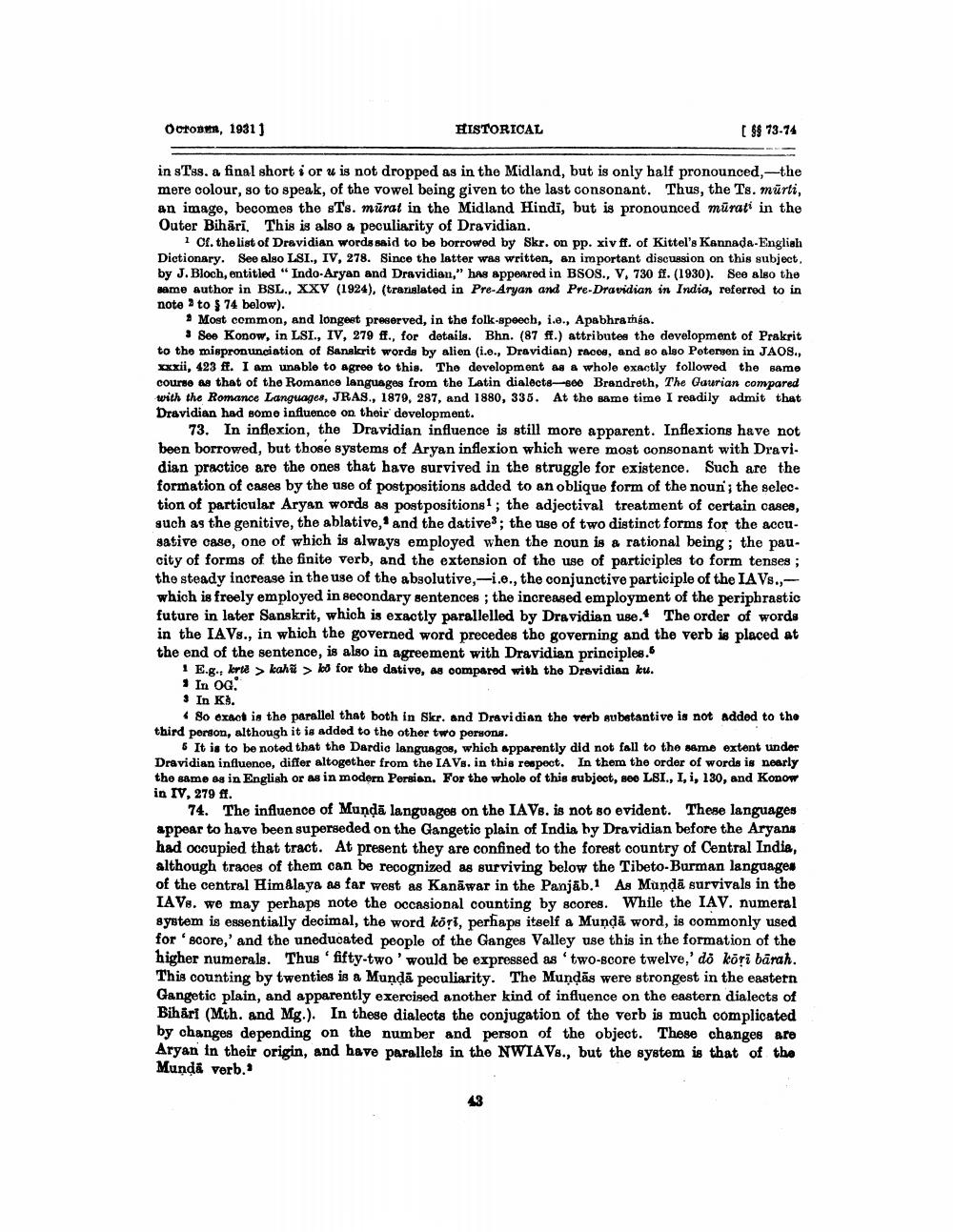________________
Octobra, 19311
HISTORICAL
[ $$ 73-74
in sTss. a final short i or u is not dropped as in the Midland, but is only half pronounced,--the mere colour, so to speak, of the vowel being given to the last consonant. Thus, the Ts. mūrti, an image, becomes the sTs. mūrat in the Midland Hindi, but is pronounced mūrati in the Outer Bihäri. This is also a peculiarity of Dravidian.
101. the list of Dravidian words said to be borrowed by Skr. on pp. xiv ff. of Kittel's Kannada-English Dictionary. See also LSI., IV, 278. Since the latter was written, an important discussion on this subject. by J. Bloch, entitled "Indo-Aryan and Dravidian," has appeared in BSOS., V, 730 ff. (1930). See also the same author in BSL., XXV (1924), (trazislated in Pre-Aryan and Pre-Dravidian in India, referred to in note to $74 below).
Most common, and longeet preserved, in the folk-speech, i.e., Apabhrarga.
3 See Konow, in LSI., IV, 279 ff., for details. Bhn. (87 ff.) attributes the development of Prakrit to the mi pronunciation of Sanskrit words by alien (i.e., Dravidian) races, and so algo Petersen in JAOS., xxxii, 423 ff. I am unable to agree to this. The development as a whole exactly followed the same course as that of the Romance languages from the Latin dialects-B60 Brandreth, The Gaurian compared with the Romance Languages, JRAS., 1879, 287, and 1880, 335. At the same time I readily admit that Dravidian had some influence on their development.
73. In inflexion, the Dravidian influence is still more apparent. Inflexions have not been borrowed, but those systems of Aryan inflexion which were most consonant with Dravi. dian practice are the ones that have survived in the struggle for existence. Such are the formation of cases by the use of postpositions added to an oblique form of the noun; the selec. tion of particular Aryan words as postpositions ; the adjectival treatment of certain cases, guch as the genitive, the ablative, and the datives; the use of two distinct forms for the accusative case, one of which is always employed when the noun is a rational being; the paucity of forms of the finite verb, and the extension of the use of participles to form tenses ; the steady increase in the use of the absolutive, i.e., the conjunctive participle of the IAVs.,which is freely employed in secondary sentences ; the increased employment of the periphrastic future in later Sanskrit, which is exactly parallelled by Dravidian use. The order of words in the IAVs., in which the governed word precedes the governing and the verb is placed at the end of the sentence, is also in agreement with Dravidian principles.
1 E.g., krte > kahü > k0 for the dative, as compared with the Dravidian lu.
In OG. 3 In K.
8o exact is the parallel that both in Skr. and Dravidian the verb substantive is not added to the third person, although it is added to the other two persona.
6 It is to be noted that the Dardio languagos, which apparently did not fall to the same extent under Dravidian influence, differ altogether from the IAVs. in this respect. In them the order of words is nearly the same as in English or as in modern Persian. For the whole of this subject, se LSI., I, I, 130, and Konow in IV, 279 ff.
74. The influence of Muņdā languages on the IAVs. is not so evident. These languages appear to have been superseded on the Gangetic plain of India by Dravidian before the Aryans had occupied that tract. At present they are confined to the forest country of Central India, although traces of them can be recognized as surviving below the Tibeto-Burman languages of the central Himalaya as far west as Kanāwar in the Panjab.1 As Mundā survivals in the IAV8. we may perhaps note the occasional counting by scores. While the IAV. numeral system is essentially decimal, the word kori, perhaps itself a Mundā word, is commonly used for score,' and the uneducated people of the Ganges Valley use this in the formation of the higher numerals. Thus ' fifty-two 'would be expressed as 'two-score twelve,' do kori bārah. This counting by twenties is a Mundā peculiarity. The Mundās were strongest in the eastern Gangetic plain, and apparently exercised another kind of influence on the eastern dialects of Bihari (Mth, and Mg.). In these dialects the conjugation of the verb is much complicated by changes depending on the number and person of the object. These changes are Aryan in their origin, and have parallels in the NWIAVs., but the system is that of the Mundă verb.




